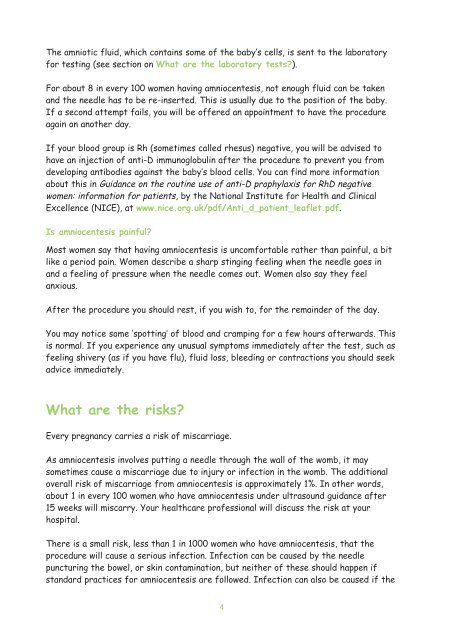Amniocentesis - what you need to know
Amniocentesis - what you need to know
Amniocentesis - what you need to know
You also want an ePaper? Increase the reach of your titles
YUMPU automatically turns print PDFs into web optimized ePapers that Google loves.
The amniotic fluid, which contains some of the baby’s cells, is sent <strong>to</strong> the labora<strong>to</strong>ry<br />
for testing (see section on What are the labora<strong>to</strong>ry tests?).<br />
For about 8 in every 100 women having amniocentesis, not enough fluid can be taken<br />
and the <strong>need</strong>le has <strong>to</strong> be re-inserted. This is usually due <strong>to</strong> the position of the baby.<br />
If a second attempt fails, <strong>you</strong> will be offered an appointment <strong>to</strong> have the procedure<br />
again on another day.<br />
If <strong>you</strong>r blood group is Rh (sometimes called rhesus) negative, <strong>you</strong> will be advised <strong>to</strong><br />
have an injection of anti-D immunoglobulin after the procedure <strong>to</strong> prevent <strong>you</strong> from<br />
developing antibodies against the baby’s blood cells. You can find more information<br />
about this in Guidance on the routine use of anti-D prophylaxis for RhD negative<br />
women: information for patients, by the National Institute for Health and Clinical<br />
Excellence (NICE), at www.nice.org.uk/pdf/Anti_d_patient_leaflet.pdf.<br />
Is amniocentesis painful?<br />
Most women say that having amniocentesis is uncomfortable rather than painful, a bit<br />
like a period pain. Women describe a sharp stinging feeling when the <strong>need</strong>le goes in<br />
and a feeling of pressure when the <strong>need</strong>le comes out. Women also say they feel<br />
anxious.<br />
After the procedure <strong>you</strong> should rest, if <strong>you</strong> wish <strong>to</strong>, for the remainder of the day.<br />
You may notice some ‘spotting’ of blood and cramping for a few hours afterwards. This<br />
is normal. If <strong>you</strong> experience any unusual symp<strong>to</strong>ms immediately after the test, such as<br />
feeling shivery (as if <strong>you</strong> have flu), fluid loss, bleeding or contractions <strong>you</strong> should seek<br />
advice immediately.<br />
What are the risks?<br />
Every pregnancy carries a risk of miscarriage.<br />
As amniocentesis involves putting a <strong>need</strong>le through the wall of the womb, it may<br />
sometimes cause a miscarriage due <strong>to</strong> injury or infection in the womb. The additional<br />
overall risk of miscarriage from amniocentesis is approximately 1%. In other words,<br />
about 1 in every 100 women who have amniocentesis under ultrasound guidance after<br />
15 weeks will miscarry. Your healthcare professional will discuss the risk at <strong>you</strong>r<br />
hospital.<br />
There is a small risk, less than 1 in 1000 women who have amniocentesis, that the<br />
procedure will cause a serious infection. Infection can be caused by the <strong>need</strong>le<br />
puncturing the bowel, or skin contamination, but neither of these should happen if<br />
standard practices for amniocentesis are followed. Infection can also be caused if the<br />
4
















